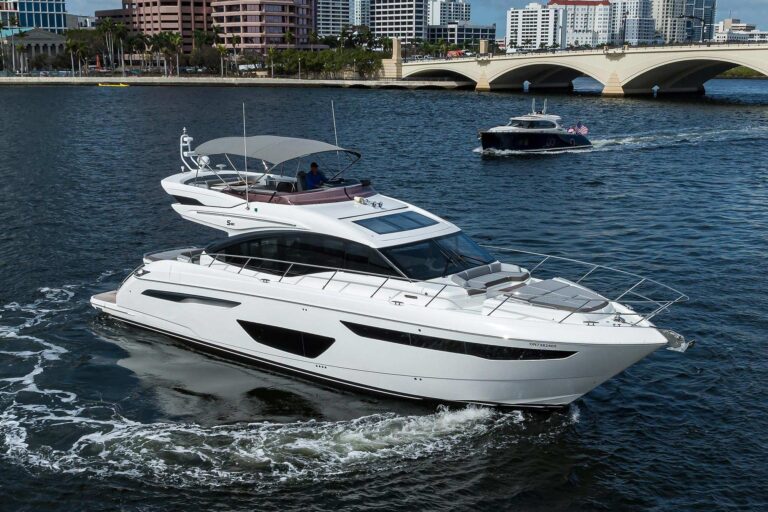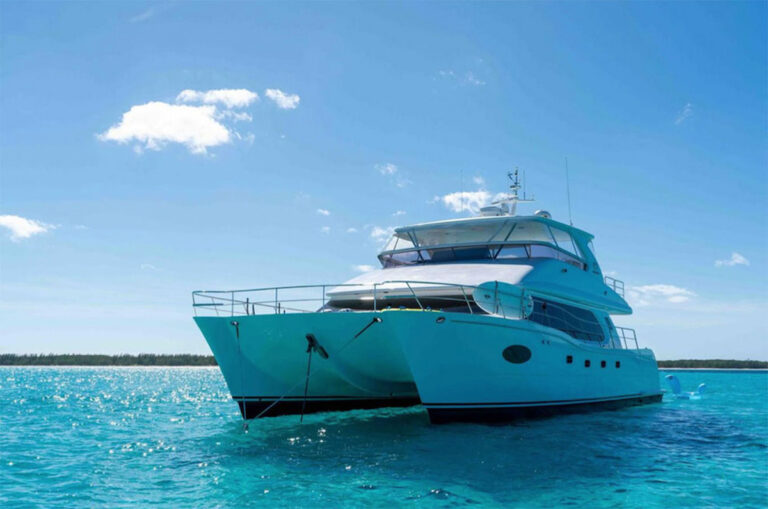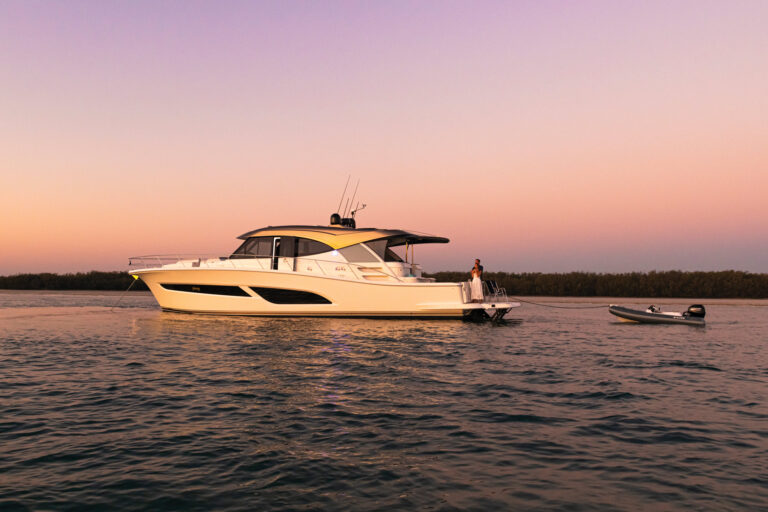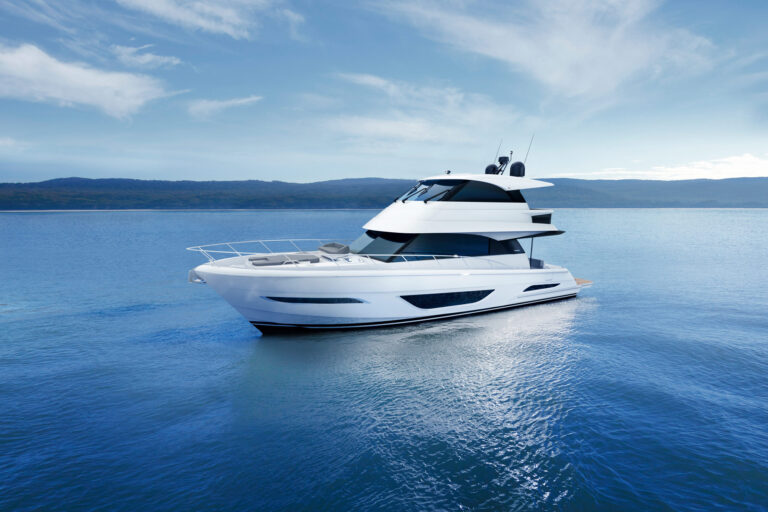Four of us lazed in the cockpit of Tijereta, a vintage Bertram. She was stern-anchored toward the sugar beach at Las Palmillas, her bow toward the sun. The water was 4 feet deep and Bahamian blue-green. But this wasn’t the Bahamas; the palm forest was way too lush, and the quiet words exchanged by the captain and mate in the flying bridge were Spanish.
No, this was no hardscrabble island. This was the southeastern coast of the Dominican Republic, as fertile a place as you will find anywhere on the planet. We gringos were guests of José Gonzalvo, general director of the new Casa de Campo Marina near the city of La Romana. Gonzalvo, known to his peers as Josie, was showing us how Dominican yachtsmen like to enjoy weekends in the fellowship of family and friends, at least when the sportfishing enthusiasts among them are not stalking pelagics out in deeper Caribbean waters.
We spent a good part of the day playing at nothing, just eating, drinking, swimming and discussing great issues of the day. Tranquilo, or tranquil, is the watchword among Dominicans, be they humble or haughty, and we were caught up in the spirit. Then Gonzalvo gave the word, and our dusky captain (with the unlikely nickname “Blondie) lit up Tijereta’s twin Detroit diesels for the 40-minute run back to Casa de Campo, one of the Caribbean’s premier resorts and luxury residential complexes.
We roared past the tourist catamarans returning to the resorts at Bayahibe and a score of 20-foot, tourist-laden dories Gonzalvo called “gremlins. Except for our wake, tranquilo describes the seas here, as well. Unlike the Domincan Republic’s fearsome northern coast, the land here curls southward, sheltering inshore waters against the unceasing easterly trade winds, more so with the winter trades, which tend to veer north of east. “Sure, sometimes we get seas here, Gonzalvo said, “but they are almost never more than 4 feet.
Like the old conquistadors, I suppose, I’ve always looked at the underbelly of the Dominican Republic strategically. To me, this coast was a natural-and sheltered-path between southern Cuba and Puerto Rico and the Lesser Antilles.
Too bad politics have postponed Casa de Campo’s role as a stop en route to and from the Workers’ Paradise, but after Las Palmillas and a stay at the Casa de Campo resort, the strength of the Dominican Republic’s southeastern coast as a destination in its own right became evident. It isn’t that far off the beaten path: only a 50-mile detour from a typical Florida-to-Puerto Rico passage when refueling at the Turks and Caicos.
The marina opened in late 2001, boasting 186 slips of 30 to 150 feet. As Tijereta idled toward the breakwater after our day at Las Palmillas, construction crews were busy building a second, more massive breakwater, creating another half-mile ring of stone that eventually will protect 162 more boats from 50 to 250 feet. The price tag on this expansion is $14 million (which will include a finisterre piano bar at the breakwater’s tip).
I noted, however, that many of the proposed big-boat berths are not berths at all but Med-mooring spaces. Not to worry: Gonzalvo said many of the 50- to 60-foot berths will be alongside the marina’s well-executed reinforced-concrete finger piers. Meanwhile, he said, multiple fueling stations will allow larger Med-moored yachts to take on diesel without having to move, though the expansion also includes a second, diesel-only fuel dock. Gonzalvo also said that while he understood the American preference for infrastructure over passerelles, the Med-mooring system was consistent with the marina’s Italian motif.
The marina, you see, is actually an entire seaside village, designed by Italian architect and sailor Gianfranco Fini. As someone who’s spent a lifetime in seaside towns that evolved haphazardly over centuries, I found it fascinating to see a functioning little port sprung full-grown from the mind of one man, inspired by but not shackled to the past.
Fini has a home at Casa de Campo, and as I shook his hand I couldn’t help envying the elegant gentleman, living as he does in the midst of a world he created.
When Capt. Blondie brought Tijereta alongside the docks, we disembarked just a few steps from the elegant Casa de Campo Yacht Club. More impressive than the bricks and mortar was the founders’ understanding of the need to invest not just in the fancy accouterments of yachting, but in the skills of the next generation. The club has begun a sailing school with four new J-24s and instructors from its affiliated squadron in Sardinia.
Earlier in this article I used the phrase “Dominican yachtsmen. If your reaction was skepticism, you would not be alone. As a group, we gringos are largely ignorant of the Caribbean’s biggest economy. Surely a place as large as Vermont and New Hampshire combined, with a population the size of Massachusetts’, will produce a significant urban elite, and it has. For those in that group, Casa de Campo’s name-it means “house in the country-is interpreted literally.
Nevertheless, I was surprised when Gonzalvo told me that almost as soon as the ink had dried on the marina’s expansion plans, prominent Dominicans had reserved nearly every berth. The rub: Most subsequently canceled after one of the nation’s biggest banks collapsed. Clearly, widespread lack of confidence in the current government and a devaluated Dominican peso had played a part, as well. As the investor class looks forward to next year’s presidential election, work on the breakwater continues.
Certainly, no political disaffection was in evidence that Friday night as we dined at Plaza Portofino, a semicircular piazza with its open side facing the docks. The piazza’s four restaurants, including ours, a place called Peperoni, have open-air seating. The piazza was packed. Men gave each other big abrazos and women kissed cheeks, supporting Fini’s observation that before Portofino, residents of Casa de Campo’s 2,000 villas tended to gather in small groups in one another’s homes. Now, the grand piazza serves as a true social center for the community.
Convenient to the docks, on the rear side of the piazza and waterfront cafés, are specialty shops, boutiques and art galleries to draw the eye and slim the wallet. Here, you’ll find a wide selection of exquisite treasures and contemporary designer wear for men and women, ranging from swimwear and lingerie to evening wear and accessories. One shop offers elegant serving dishes and cookware embellished with shimmering ruby handles that would make even the simplest fare an objet d’art. Another shop boasts Italian-designed evening wear made from sumptuous chiffons, gilded silks and fresh linens, tailored for a romantic dinner or a festive cocktail party.
Within this sprawling 7,000-acre compound is another replicated Mediterranean village, called Altos de Chavon, situated on a bluff above the Chavon River. This village, with its artificially weathered stonework, is home to more restaurants, shops and a nightclub. It also houses a private design school.
The views from there are stunning, and so is the 5,000-seat amphitheater, suitable for some provincial capital of the old empire. Frank Sinatra, Carlos Santana and Gloria Estefan are among the internationally known artists who have performed here.
If you’ve heard of Casa de Campo, it is probably because of its status as a world-class golf resort. Its oceanfront Teeth of the Dog course, designed by Peter Dye, was carved out of an old airport in the early 1970s. The golf press consistently describes Casa de Campo as best in the Caribbean. In fact, Golf Magazine rated Teeth of the Dog among the top 35 courses in the world for 2003. When I saw how some of the holes jut into the sea, I understood why it’s reputed to be one of the world’s wettest courses, as well.
Golf was a given, and so were sportfishing opportunities and water sports, but what surprised me were the resort’s unique recreational offerings. Who would have thought you could get polo lessons and watch polo matches in the Dominican Republic? Ditto for skeet. The shooting program includes a kennel and the services of dog-training experts.
Because of its nearby international airport, Casa de Campo is also one of the best marinas in the Caribbean for friends and crew to reach by air. La Romana has daily flights to Miami, New York and San Juan on American Airlines, while USAir offers flights from its hub in Charlotte, North Carolina. With even more options, Santo Domingo’s airport is only an hour and a half away.
For those who are looking to venture beyond the luxury of the resort, the marina makes an excellent-and secure-staging point. The hinterlands of the Dominican Republic are not for everyone, but an experienced traveler would be well rewarded by hiring a rental car and exploring this beautiful and idiosyncratic nation, where a surprise awaits around every corner. At night, of course, this has its disadvantages. Avoid driving after sunset, unless you’re unfazed by a taillights-optional environment. A more conservative approach would be to join a guided tour of, say, the Colonial Zone of Santo Domingo.
Casa de Campo’s proprietors are to be commended for their vision and efficient delivery of services. If you’re a yachtsman who golfs, don’t pass this place by. If you dock here long enough, you may benefit in less tangible ways, too. Dominicans, whatever their station in life, are among the friendliest people on the planet-to them, friendship is second only to family. It’s a notion taken very seriously. Make a friend at Casa de Campo, and you’ve got a friend for life.
Contact: Casa de Campo Marina, (809) 523-8646; www.casadecampomarina.com. For more information, contact: (866) 922-4877; www.yachtingnet.com/yachting/productinfo.









